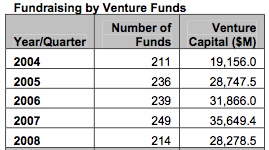Yesterday, TechCrunch reported the news that Yahoo! is planning to shut down Geocities. That is sad news on many levels. Geocities was the web's first community and it was my first "mega deal" when it was sold to Yahoo! in 1999 for $3.5bn (including the value of the options Yahoo! assumed). I learned a lot from that investment and I thought I'd share some of the lessons with you all this morning.
My partner at Flatiron, Jerry Colonna, who led the Geocities investment, will read this post and will surely correct all the things I get a little wrong so make sure to read the comments. I do have the benefit of having all the cap tables and investment memos still on my laptop so most of this is based on more than memory.
In the summer of 1996, Jerry and I formed Flatiron Partners. We wanted to focus exclusively on Internet investments. We quickly rounded up two $75mm commitments from SOFTBANK and Chase and by the fall we were off to the races.
Our first investment was Seth Godin's company Yoyodyne which we had both been looking at while we were at our prior firms (Jerry was at CMGI and I was at Euclid). As we were considering what next investments to make, I suggested that we each pick a company from the portfolios of our prior firms to make an investment in. I felt that we could use a couple "sure winners" and there is nothing like cherry picking a venture fund you know well to produce a sure winner.
Jerry liked that idea. I picked Multex (which went on to go public and then sell to Reuters for $250mm). Jerry picked Geocities.
 Image of David Bohnett via Wikipedia
Image of David Bohnett via Wikipedia
Jerry flew out to Los Angeles where Geocities was headquartered (it was initially called Beverly Hills Internet) and talked to David Bohnett, the founder of the company. Jerry knew that the initial $2mm that David had raised from CMGI was going to run out shortly and so he proposed that Flatiron invest $8mm at a $10mm pre-money valuation.
David immediately liked the idea of having Jerry as an investor. He knew Jerry from CMGI and they had a great relationship. But he hated the idea of selling 45% of the company when he had already sold 50% of it to CMGI earlier for $2mm.
When we showed up, CMGI owned half the company and David owned less than 35%. The rest was in the hand of friends and family and options. David felt that he had made a bad deal with CMGI and wanted to fix that in the next round.
So Jerry invited David and his brother Bill out to NYC to meet with the two of us and figure it out. We went out to dinner at a place in the lobby of the Met Life Building (which I still think of as the Pan Am Building) and discussed the issue at length.
At that dinner, I proposed that we issue David 500,000 options as part of the financing which would be 10% of the company post financing. He and Bill went outside to talk it over and they came back and told us we had a deal.
So we drafted up a term sheet and sent it to David. Flatiron and our partners SOFTBANK and Chase would lead an $8mm financing at a $10mm valuation. CMGI would invest $2mm of the $8mm and we'd issue 500,000 options to David. We'd add to the employee pool as well. After the financing, Flatiron and our partners would own about 30% for our $6mm, CMGI would own about 33%, and David would own north of 20%.
David liked the proposal and he sent it to CMGI for their approval. They hated it. To this day, I'm not sure if it was the fact that a former partner, Jerry, was showing up and attempting to invest in their little secret or if it was just the financial terms. But whatever the case, they fought the idea for a while. I don't recall exactly what the delay was all about. I assume they were looking around for a better option. But finally they came to the table.
They demanded that we split the 500,000 options and give half of them to CMGI and half to David. They saw them as a sweetener for David, which they were, and wanted to participate. After a lot of back and forth, none of it pleasant, David conceded. And in the late fall of 1996, the financing closed.
Three years later, when Geocities was sold to Yahoo!, those 500,000 options I came up with over dinner in the old Pan Am Building lobby were worth $234mm. By then they had split 2 for 1 twice and David had given a bunch of them to his co-founders. CMGI still had all of theirs.
We decided to invite a couple of other VCs into the deal. I was concerned that Geocities was in LA and we were in NYC and CMGI was in Boston. I felt that we needed a local VC to "watch over the deal". The only VC I knew in LA was Harry Lambert of Innocal, who had previously been at Innoven in New Jersey. So I called up Harry and asked him to go see David. They hit it off and so we allocated $1.75mm of the deal (which we increased to $9mm) to Innocal. We also invited Intel into the deal, also allocating them $.175mm. Between Intel, Innocal, SOFTBANK's Charley Lax, and Bob Greene from Chase, we had quite a few VCs involved in that first round.
I've always felt that syndicating a deal to other VCs who can be helpful is a good idea. In the case of Geocities, we cut ourselves back by $3.5mm, which ultimately became worth $500mm, and I'd do it all over again. Intel wasn't particularly helpful as investors, but their brand was helpful to the company who used it actively. But Harry was a big help. Less than six months after we made our investment, the company was burning through cash and there were no financial controls in place. Harry showed up with his team and got things under control, fixed the financial management, and bought enough time to get another round raised.
As we were getting ready to close our initial round of financing, the November 1996 Media Metrix numbers came out. Geocites, which was growing like crazy, had made it into the top ten. I turned to Jerry (we shared an office back then) and said to him with a big smile "we are about to invest in one of the top ten internet companies in the world at a $10mm valuation." Not many people understood how big a deal that was back then, but we did.
We did not have an investment analyst on our team at that time and we needed to do a lot of work on the market and what the other home page services were and what their tools were like. Jerry called up Jason Calacanis, who I had not met at the time, and we brought him in and hired him as a consultant. He was young and smart and a wiseass. Some things don't change. Jason did all of our deep analysis on the Geocities deal. He didn't get any Geocities stock out of it, but he did get Flatiron as the advertising sponsor for the first issue of Silicon Alley Reporter out of that gig.
After Harry and his team got the finances under control, Geocities started to prepare for another round of financing. It was the summer of 1997 and the Internet investing climate was not great. We did an insider round at 4x the last round price and raised another $5mm.
But by the end of 1997 and into early 1998, things were heating up and SOFTBANK and Yahoo! had their eyes on Geocities. The two companies proposed to invest $25mm into the company at a $225mm valuation and also do a $50mm secondary purchase from the investors. All of the investors in the initial round other than CMGI and SOFTBANK participated and Flatiron and Chase sold a third of our position to SOFTBANK and Yahoo! at $15/share (post a 2/1 split so actually $30/share pre split). That was almost 10x on our purchase price in less than two years. By selling a third of our position for 10x what we paid, we locked in a 3x on the deal and still had 2/3 of our investment working for us.
When the company went public a year later and eventually sold for $120/share to Yahoo!, Jerry and Bob Greene (our partner at Chase and eventually our partner at Flatiron) asked ourselves if we had made a mistake selling a third of our position in December 1997 and January 1998. I didn't think so and I still don't. Yes, the shares we sold for $15/share would have split 2/1 once more and would have been worth $120/share in the Yahoo! sale, but I don't think you ever should regret taking a 10x gain and taking some money off the table. We did that and I don't regret it one bit.
The rest of the story is pretty well known. Around the time of the Yahoo!/SOFTBANK investment, David recruited Tom Evans to join the company as CEO. Tom took the company public in 1998 and sold it to Yahoo! in 1999. Tom did not join Yahoo! and went on to build and run several very successful public companies. David made a bundle in the sale of Geocities, turned his energies to other interests for a number of years, but is now back in the saddle as the founder of another internet startup in LA.
And Jerry, Bob, and I went on to exit from dozens of internet deals in 1998, 1999, and 2000 before the market blew up and Flatiron stopped making investments in the summer of 2000. Between all the big exits we had in Flatiron and a number I've had since, you might think that Geocities is just another deal. But for me, it was the first rocket ship ride I had in the venture business and it will always have a special place in my head and heart because of that.
I learned a lot from that deal. I learned that the Internet is all about people expressing themselves on pages they own and control. I learned that a business deal made over dinner and a handshake can turn into hundreds of millions of dollars, I learned that good partners are worth every penny of returns you give up to get them, and I learned that selling too soon is not too painful as long as you don't sell too much. And most of all I learned that you can make 100 times your investment every once in a while. And when you do, it's something special.
![Reblog this post [with Zemanta]](http://img.zemanta.com/reblog_b.png?x-id=4f4c9d4f-d6fb-41da-96ad-fa204acec716)



![Reblog this post [with Zemanta]](http://img.zemanta.com/reblog_b.png?x-id=509cc321-d62b-42c1-9932-8a5b5f4a2ea3)
![Reblog this post [with Zemanta]](http://img.zemanta.com/reblog_b.png?x-id=48d0e243-3552-4534-9ab9-1f865d1e8fd2)
![Reblog this post [with Zemanta]](http://img.zemanta.com/reblog_b.png?x-id=b4f3e6f2-ccc7-4ea6-92b4-012d5dadbaee)
![Reblog this post [with Zemanta]](http://img.zemanta.com/reblog_b.png?x-id=607487c5-ea27-4aba-9dd3-78b76e51a336)

![Reblog this post [with Zemanta]](http://img.zemanta.com/reblog_b.png?x-id=c5a01a37-d69c-4085-8037-7f162764e282)

![Reblog this post [with Zemanta]](http://img.zemanta.com/reblog_b.png?x-id=a5dbda8e-6aae-4aa0-aa0b-e3395a8a0bcb)
![Reblog this post [with Zemanta]](http://img.zemanta.com/reblog_b.png?x-id=5d6e7e88-365b-4b7d-9115-93c630072f12)
![Reblog this post [with Zemanta]](http://img.zemanta.com/reblog_b.png?x-id=84f417a2-a4c8-48dd-877c-a023aaffad3b)
![Reblog this post [with Zemanta]](http://img.zemanta.com/reblog_b.png?x-id=cf86088f-88b7-4030-8768-ff843cf8bed3)